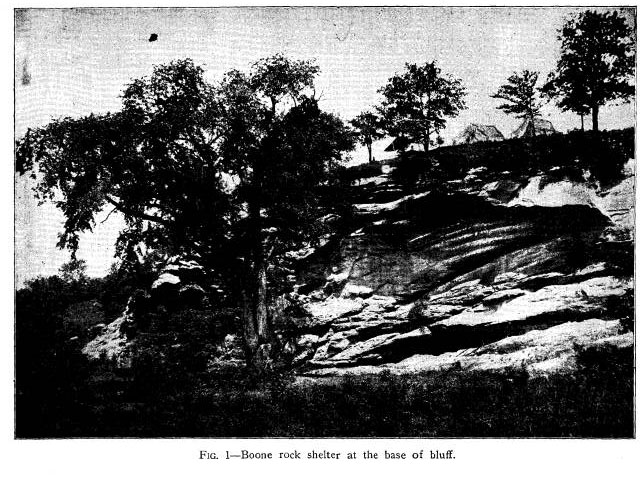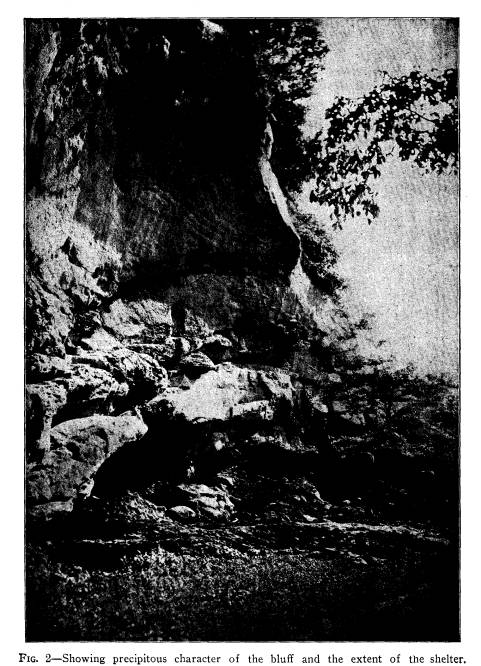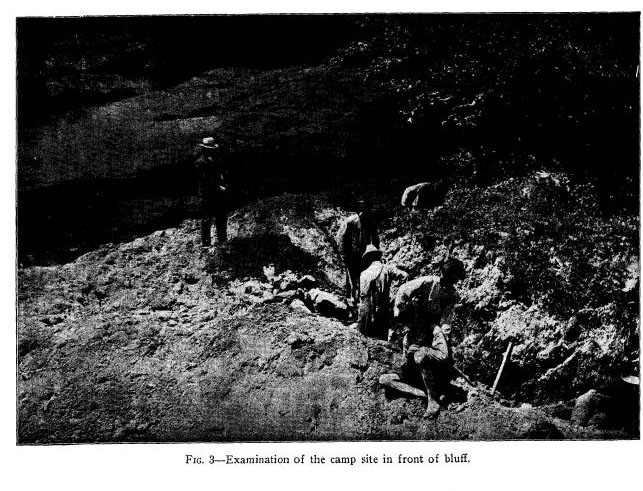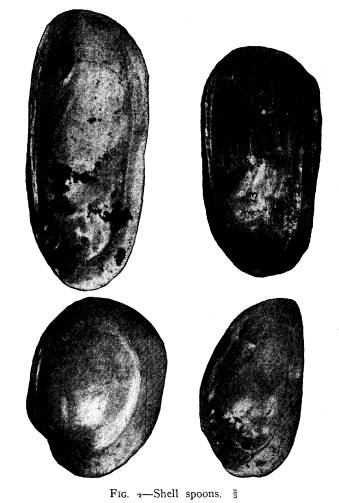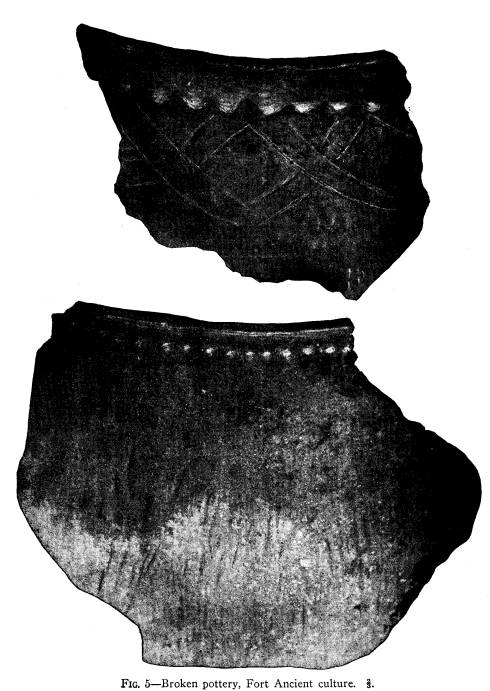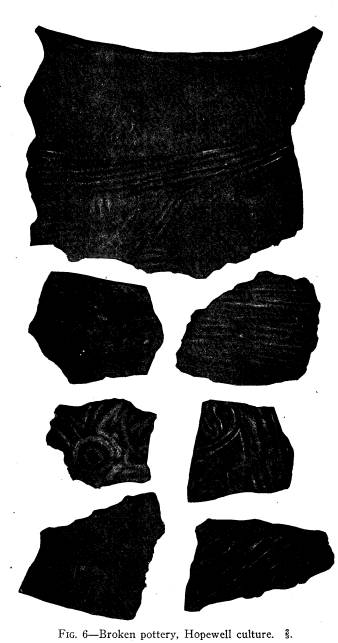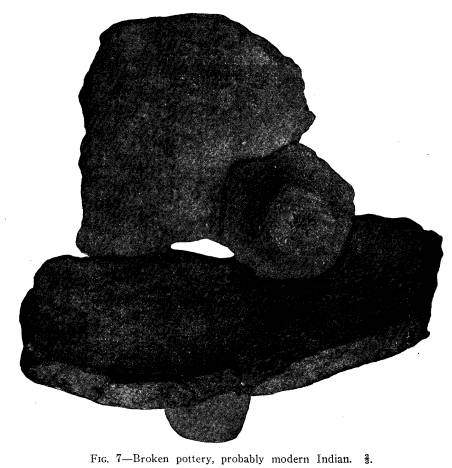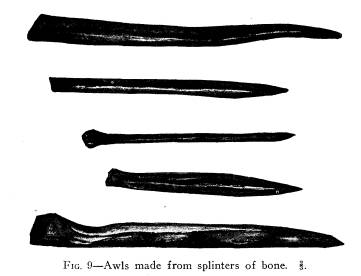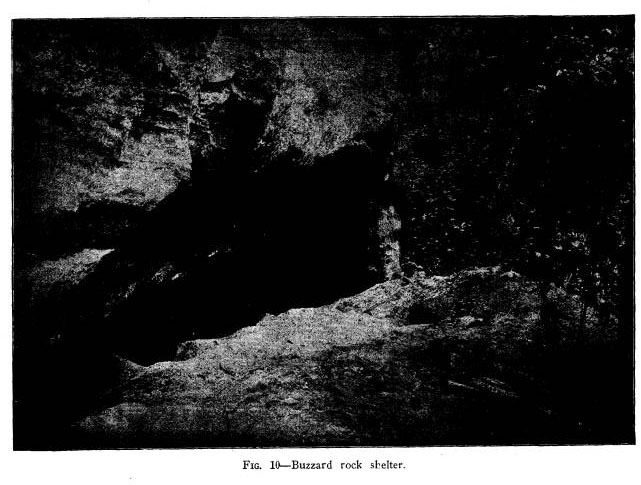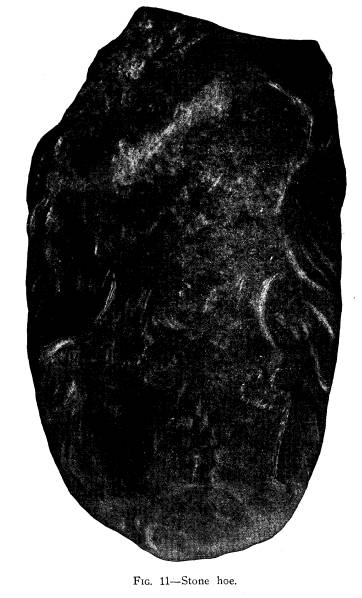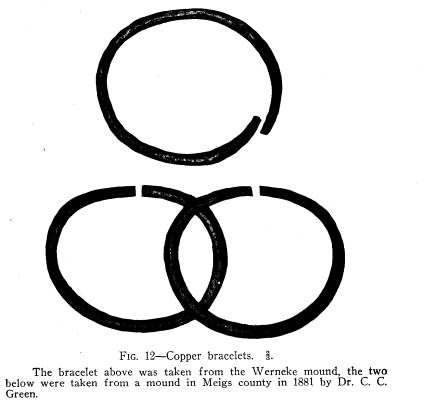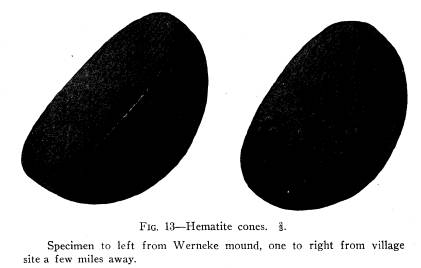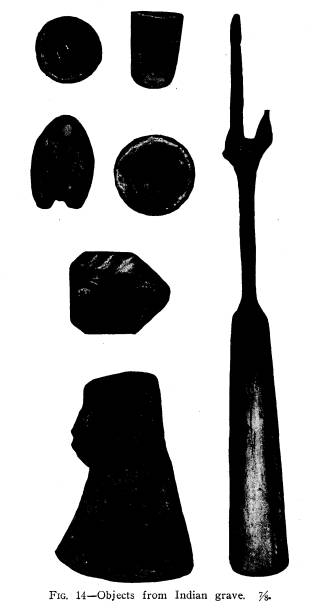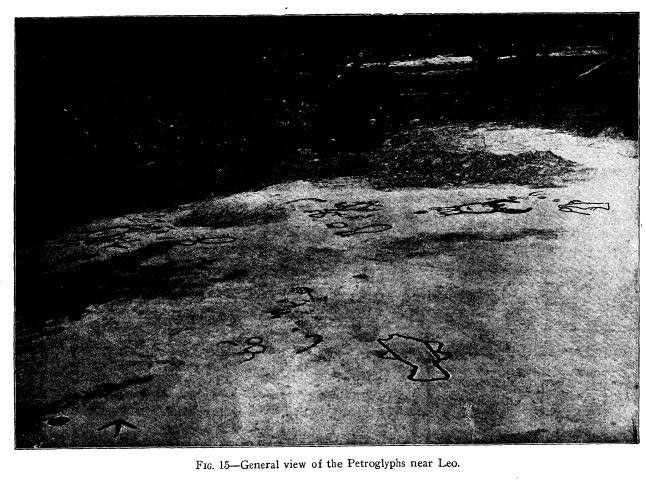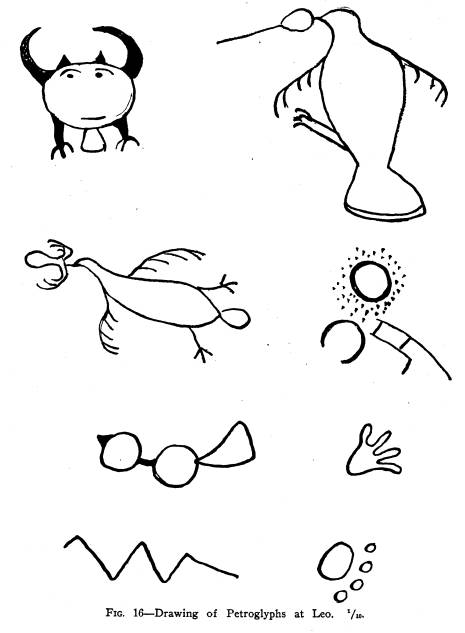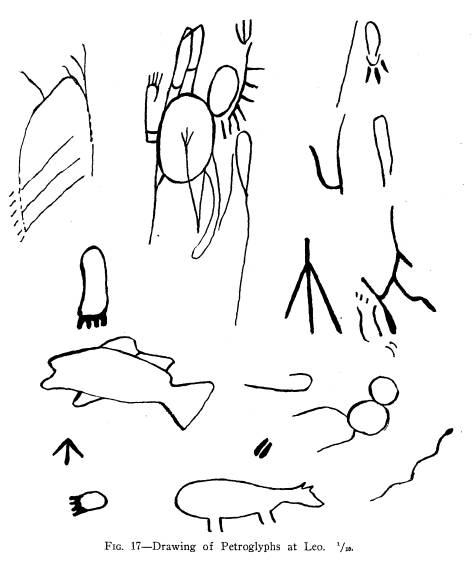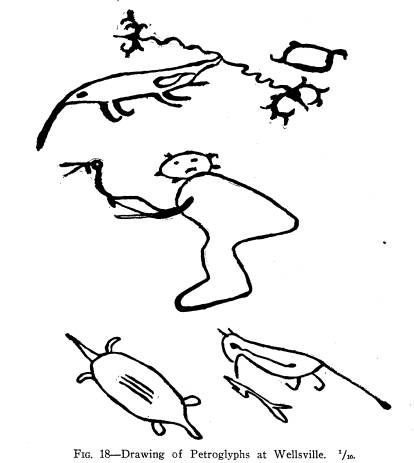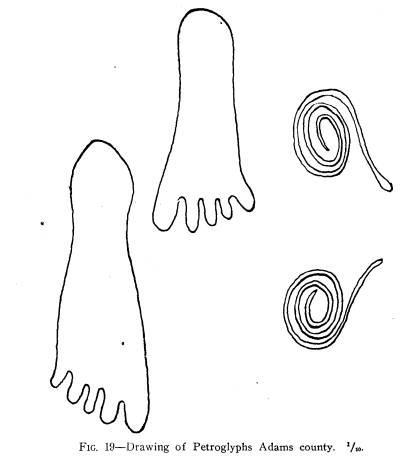Ohio History Journal
- 1
- 2
- 3
- 4
- 5
- 6
- 7
- 8
- 9
- 10
- 11
- 12
- 13
- 14
- 15
- 16
- 17
- 18
- 19
- 20
- 21
- 22
- 23
- 24
- 25
- 26
- 27
- 28
- 29
- 30
- 31
- 32
- 33
- 34
- 35
- 36
- 37
- 38
- 39
- 40
ARCHAEOLOGICAL
REMAINS OF JACKSON COUNTY
BY WILLIAM C. MILLS.
INTRODUCTION.
During the summer of 1905, by special
request of a number
of citizens and local archaeologists of
Jackson county, the Ohio
State Archaeological and Historical
Society sent an expedition
into the county, under the direction of
the writer, which examined
a few of the many rock shelters, mounds
and petroglyphs located
in Lick, Liberty and Jackson townships.
The object of the
examination was to determine, if
possible, whether the rock
shelters and other places of abode were
occupied for any great
length of time as a domicile by
prehistoric man or were used
as a temporary and convenient stopping
place for roving bands
in search of food.
TOPOGRAPHY.
Jackson county, for the most part, is
very rough and hilly.
The entire surface, taken as a whole,
being an irregular suc-
cession of moderately high hills and
deep ravines, making it
undesirable for a permanent habitat for
a people depending for
their subsistence in some degree upon
the cultivation of the soil.
Along the streams there are broad and
beautiful valleys and
in the eastern part of the county the
hills exhibit more gradual
slopes as compared to the western
section of the county, where
the conglomerate hills are often very
steep, and the deep chan-
nels, cut through them by Salt Creek and
its many tributaries,
often present precipitous faces for a
height of sixty feet or
more, giving to the scenery a bold and
mural character.
SOIL.
The soil of Jackson county is not well
adapted to the raising
of cereals, as it is for the most part a
thin covering over the
rocks and this is especially true of the
western part of the county,
(175)
176 Ohio Arch. and Hist. Society Publications.
where the hills and rocky ridges are
simply the remnants of
what was once a continuous rock strata.
In the central and eastern part of the
county, where the blue
and ferruginous limestones are found,
the soil is richer but better
adapted to grass although with proper
treatment good quality of
cereals are raised.
GEOLOGY.
From a geological point of view Jackson
county has pre-
sented many interesting features, producing
a coal of high stand-
ard, iron ore of superior quality, and
from her salt springs per-
haps the first salt produced, in a
commercial way, in the state.
The old Scioto Salt Works, then located
on the banks of Salt
Creek, near what is now the city of
Jackson, was the first salt
factory in the northwest to produce salt
for the market.
HISTORICAL.
From the early histories of Ohio we find
that salt was one
of the most expensive of the necessities
of the early settler and
almost up to the time that Ohio was
admitted into the Union as
a state, all of the salt used was
transported on horseback or in
wagons across the mountains, causing the
supply to be very often
scanty and the price always very high.
However, the early set-
tlers found that Jackson county was a
favorable hunting ground
with the Indian, and perhaps through
them the salt springs were
located, and naturally the manufacture
of salt from the brines
would follow.
The exact date of the discovery of the
salt springs by the
whites is unknown, but it was probably
early in the eighteenth
century by the French Canadian fur
traders through their barter
with the indians. The Virginia colonists
did not attempt to
make use of the salt springs until the
close of the eighteenth cen-
tury (1798), although they were familiar
with their location and
existence about the middle of the
century.
The John Mitchell map of the British and
French Dominions
in North America, 1755, has a note of
the salt licks and salt
creeks furnishing salt for the inland
country. Salt Creek is also
marked upon this map. The saline water
of this region was very
178 Archaeological Remains
of Jackson County.
weak and it would often require ten to
fifteen gallons of the
water to make one pound of salt. The
salt was distributed to
the settlements by pack horses. So
important was this source
of supply to the inhabitants that, when
Ohio was formed into
a state, a tract of land six miles
square, embracing the saline
waters, was set apart by Congress for
the use of the state. In
1804 an act was passed by the
Legislature of Ohio regulating the
management of this tract and appointing
an agent to rent small
lots on the borders of the creek for the
manufacture of salt.
Salt for the most part was made by
evaporating the saline water,
and this was done by constructing salt
furnaces made by sur-
rounding large iron kettles, of 30 to 40
gallons capacity, with
stonework having a furnace beneath. But
the large iron kettles
were difficult to secure at this remote
manufacturing site in the
wilderness, and the slower process of
evaporation by natural
means was used during the summer season.
This evaporation
was accomplished by cutting out large
wooden troughs and plac-
ing same in the sun, filled with salt
water; also circular shallow
holes were cut in the solid rock of the
creek bottom and the salt
water run into them. Several holes used
for this purpose can
still be seen in the creek bed near
Boone Rock, but all traces of
the old salt works are obliterated.
From an archaeological standpoint the
salt springs of Jack-
son county are of great interest, for
within short distances from
the springs are a number of rock
shelters containing quantities of
broken earthen vessels of the type of
pre-Columbian man, indi-
cating that he, too, was a frequenter of
the saline springs in the
never-ending search for food, for he,
like all mankind in every
clime, has searched the animal, the
vegetable, and the mineral
kingdom in his struggle for existence.
Other evidence of prehistoric man's
presence in Jackson
county is not wanting, especially in the
central and eastern part of
the county along the many tributaries
and headwaters of Salt
Creek, where he has left many small
monuments in the way of
mounds often containing a single burial.
Mr. F. E. Bingman, the well-known
architect of Jackson,
has devoted much time and study to the
archaeological remains
of Jackson county and has written a
series of articles on the
180 Ohio Arch. and Hist. Society Publications.
"Archaeology of Jackson County," published in one of the local
papers in Jackson, beginning January 9th, 1897, and he has
kindly
granted me the liberty of quoting from these articles, especially
those concerning the rock shelters and mounds, as Mr. Bingman's
writings are available only where files of the paper are kept.
Mr. Bingman did some excellent archaeological work in locat-
ing mounds and village sites upon the archeological map of
Jackson county, and we are greatly indebted to this gentleman
for the exact location of practically all of the earthworks,
mounds, village sites, and rock shelters in the county. A tabu-
lated list of the various remains by townships is found herewith:
Mounds. Shelters. Villages. Enclosures. Petro-
glyphs.
Jackson township ...... 2 1 .. 1
Liberty township ..... 3 17 1
Scioto township ...... 7 2 1
Washington township . 6 2 1
Coal township ........ 17 1 2
Lick township ........ 44 4 9 2
Franklin township .... 31 .. 5 1
Jefferson township .... 17 .. .. 2
Milton township ...... 23
Bloomfield township.... 12 1
Madison township .... 8 2
168 31 20 5 1
ROCK SHELTERS.
During our stay in the county we examined three of the
largest and most promising of the so-called rock shelters located
in Lick, Liberty and Jackson townships. The examinations were
made to determine, if possible, whether the shelters were occupied
for any great length of time as a domicile by prehistoric man or
were used only as a temporary and convenient stopping place for
roving bands in search of food. These shelters are merely
recesses cut into the soft conglomerate rock by the action of the
water in the bed of the stream, and in the course of time, as the
bed of the stream would change by becoming deeper or by the
shifting of the current to the opposite side, where perhaps another
182 Ohio Arch. and Hist. Society Publications.
recess would be formed, and at the same
time leave the opposite
shelter accessible for man. This
condition we find in many of
the rocky gorges, with a series of large
and small recesses, some
of which would be available for man's
use. At present about
thirty-one of these recesses, both large
and small, have been found
to contain traces of human habitation.
Mr. Bingman, in his article
"Archaeology of Jackson County,"
gives a detailed account of the
shelters, and we quote at some
length from his article:
"The western half of Jackson county
is underlaid with a
heavy conglomerate, which is cut through
in many places by the
streams, presenting bold and precipitous
cliffs. Many small
caverns, admirably adapted for shelters,
and overhanging rocks
occur in and beneath these cliffs and
were made use of here as
elsewhere. These shelter caves in
Jackson county are all small
and low, and none of them bear any marks
of having been
enlarged artificially or altered in
outline by the users. Many,
especially the small overhanging cliffs,
seem to have been used
merely as temporary stopping places
perhaps by small hunting
parties, the accumulation of refuse
being small, and the imple-
ments few, mostly flaked tools and
weapons of chert. Pottery
occurs sparingly in these, and domestic
implements are absent.
But the enormous amount of refuse, the
presence occasionally of
small stationary mortars and, in some,
of numerous domestic
implements of bone and large amounts of
potsherds, point to long
continued use. Of this latter class the
shelter on the east half
of lot 17, Liberty township, is a good
example. Here the floor
earth, the greater part of which is
ashes, averaged fully three feet
in depth over a space thirty by
seventy-five feet. The refuse in
this shelter is characteristic of all
the larger ones and consists,
besides the very large bulk of ashes, of
bones of all the native
mammalia, the larger ones invariably
split to obtain the marrow,
the bones of birds, the carapace and
plastron of the common box-
tortoise (cistudo), several species of
Unio, of land and fresh
water gasteropods, and the remains of
crayfish. Fragments of
burned sandstone, both large and small,
constitute a noticeable
proportion, while chips and small pieces
of chert, and various
|
Archaeological Remains of Jackson County. 183
other materials used in the making of tools and weapons, are more or less abundant. "The implements and ornaments scattered through the refuse |
|
|
|
are, generally, either those which had been broken and destroyed or small articles readily dropped and lost. Here are found the various flaked tools, arrow and spear heads, knives, scrapers, |
184 Ohio Arch. and Hist. Society Publications.
drills and hatchets; bone needles, awls,
daggers and beads;
innumerable pieces of pottery; numerous
small mortars cut in
fragments of sandstone; hammer stones,
balls and ornaments of
slate.
"These implements and ornaments do
not differ in any way
from the usual ones of Indian make, from
the village sites and
elsewhere, being similar in workmanship,
material and every
other respect. Many rudely flaked tools,
evidently rejects or
unfinished implements, are also found in
these shelters.
"The age and uses of these shelters
may be easily deter-
mined from the shelters themselves and their contents. The
bones and shells are generally in a good
state of preservation,
though in the dry cave earth they might
resist decay indefinitely.
But the implements, ornaments and
pottery are all characteristic-
ally Indian.
"The bones in these shelters are
all of such animals as do
now or have within a comparatively
recent period inhabited the
county."
BOONE ROCK SHELTER.
The first of the rock shelters to be
examined by the survey
was located within the corporated limits
of the city of Jackson,
and locally known as Boone Rock.* This rock shelter is one of
the largest in the county and, perhaps,
the best and most favor-
ably known because of the great number
of Indian artifacts
found intermingled with the soil
covering the floor of the rock
shelter, as well as ground adjacent to
the shelter and precipitous
bluff to the east. From this rock
shelter, perhaps more than any
other in the county, the local
collectors have enriched their col-
lections. Among the first of the local
citizens to recognize the
shelter as prolific for relic collectors
were F. E. Bingman, Hon.
P. W. Williams, Judge H. C. Miller and
Mr. W. A. Steele. The
*According to local tradition Daniel
Boone was captured by the
Indians and confined in an old Indian
enclosure a few hundred yards
back from the bluff. He made good his
escape by jumping from the
edge of the cliff into the branches of a
large elm tree descending to
the ground while his captors were
compelled to make a circuitous route
to reach the valley of Salt creek.
186
Ohio Arch. and Hist. Society Publications.
site was also generally worked over for
many years by boys, and
the artifacts found were scattered and
many lost.
Judge Miller and Mr. Steele have both
presented the major
part of their finds to the Ohio State
Archaeological and Historical
Society, which greatly augmented the
number of artifacts found
by the survey from this shelter.
Boone Rock shelter is located at the
very base of a precipit-
ous bluff, fifty-seven feet high. The
highest point of the bluff
is almost directly above the shelter, as
shown in Figure 1,
but gradually slopes east and west, and
at a distance of a few
hundred yards the hill becomes
accessible for pedestrians and a
gradual slope leads to the top. Figure 2 shows the
precipitous
character of the bluff and the extent of
the shelter. The out-
side measurements of the shelter are
fifty-four feet in length and
the opening eleven feet high at the
center, extending into the
rock twelve and one-half feet, with a
roof abruptly sloping to
the floor of the shelter. At no place in
the shelter could a man
stand upright only at the very outer
opening. At the center of
the shelter the roof was three feet and
one inch from the floor.
The west end of the shelter was the
lowest, and very likely on a
level with the bed of the stream, for it
was filled with water dur-
ing almost the entire time of our
explorations. The floor of the
shelter gradually slopes upward to the
east, so that the east end
is two and one-half feet higher than the
west end.
CONTENTS OF THE SHELTER.
The examination of Boone Rock shelter
proper was very
unsatisfactory, as every portion of the
accumulation of debris
within the enclosure had been many times
dug over and disar-
ranged by relic hunters in their search
for artifacts, making it
impossible to draw any conclusion from
the few implements and
ornaments found scattered through the
debris upon the floor of
the shelter. So completely had the work
been done previous to
our coming that a careful examination by
the use of a small hand
trowel only gave us one arrow point of
flint, three bone beads,
one bone awl made from the
tarsometatarsus of the wild turkey,
and six small pieces of pottery. The
animal bones usually
expected to be present in the habitation
sites of prehistoric man
|
|
|
(187) |
188
Ohio Arch. and Hist. Society Publications.
were few within the shelter, and no
doubt many had been carried
away by former searchers; however,
specimens of the bones of
the Virginia deer, black bear, raccoon
and wild turkey were
secured.
Mr. John Steele, of Jackson, who had dug
into the debris of
the shelter many times during previous
years, presented the fol-
lowing specimens taken from the shelter:
Six arrow points and
two spear points of flint, one bone
bead, and one broken copper
piece, presumably a part of a bracelet.
It is Mr. Steele's opinion
that many specimens have been exhumed
from this shelter by
boys from the neighborhood, and the
majority of the specimens
are lost.
THE SITE DIRECTLY IN FRONT OF THE
SHELTER.
For many years the site directly in
front of the rock shelter
and extending a hundred feet or more in
front of the bluff to the
east was known as the "bone
yard" to many local archaeologists
and citizens of Jackson and vicinity,
and many of them found
healthful recreation in spending a few
hours at the "diggings,"
thereby increasing their collections at
every visit. Judge Miller,
Mr. Bingman and Mr. Steele, of Jackson,
and the late Mr. S. H.
Vinson, of Dayton, Ohio, and many
others, have all secured rep-
resentative collections from here. Judge
Miller and Mr. Steele
continued the explorations directly to
the south, after the writer
ceased work at Boone Rock, and secured
many animal bones, a
few artifacts, a great quantity of
broken pottery and flint spawls,
all of which they presented to the
museum. The work of Judge
Miller and Mr. Steele fully verifies the
conclusions formed by the
writer from the explorations made by the
survey directly in front
of the shelter.
DETAILED ACCOUNT OF THE CAMP SITE.
The examination of the camp site
adjacent to the rock shelter
was as systematically carried out as
possible. The work was
greatly retarded by the accumulation of
large blocks of sand-
stone that had fallen from the cliff,
and when these could not be
removed it was dangerous for the workmen
to disturb the ac-
cumulation of camp site material beneath
them. The camp site
|
Archaeological Remains of Jackson County. 189 for the most part, like the rock shelter, had been dug over in search of artifacts, etc., previous to the time of our examination, however, many phenomena of special interest were found dur- ing the progress of the work. From surface indications the |
|
|
|
camp site extended to the east of the rock shelter, and a point was selected as far west of the shelter as possible, at a point indicating the bed of the stream, and a trench was dug fifty feet in length and extending at right angles to the bluff. The |
190 Ohio Arch. and Hist.
Society Publications.
depth of the trench at the bluff was ten
and one-half inches, but
gradually increased to eighteen inches
at the end. The bottom of
the trench was perhaps the bed of the
stream at the time pre-
historic man made his appearance in the
Salt Creek valley.
The trench was widened to the east and
the dirt thrown
back by the workmen so as not to
interfere with pos-
sible finds. The soil was homogeneous throughout, very
dark in color, and evidently deposited
by the stream dur-
ing freshets. No animal bones or other
objects were found
during the first ten feet of the
widening of the trench, but
the thickness of the black soil remained
about the same. At this
point the dark soil began to diminish
and it became evident we
were leaving the creek bed, as the old
shore line of the stream
was quite plain. At this point the black
soil had diminished to
fourteen inches, and during the next ten
feet had practically dis-
appeared, being replaced by a mixture of
ashes, soil, animal bones,
etc., while the sub-soil of clay had
gradually increased to ten
inches. Animal bones and broken pottery
began to appear shortly
after leaving the old shore line of the
stream, and at five feet
from this line the first fireplace was
found. This fireplace was
eleven feet from the bluff wall and
measured approximately three
feet in diameter, circular in form and
outlined with flat pieces of
sandstone five to six inches in
thickness and placed four to five
inches apart. Sandstone pieces were also
placed on the inside
of the circle in such a manner as to
accommodate a number of
pottery vessels at one time. The ground
around and within the
circular fireplace was covered with
hundreds of pieces of pottery,
animal bones and mussel shells.
The pottery was for the most part thick
and, if one may
judge from the fragments, of large
capacity. Some of the frag-
ments were decorated with textile
markings, others with incised
scroll decorations, but practically all
of the pieces found around
the fireplaces were plain and
undecorated.
The pottery vessels were no doubt used
for preparing food
and also for the manufacture of salt
from the saline waters.
Directly to the south eight feet, and
about the same distance from
the old shore line, two more fireplaces
were found in close prox-
imity to each other, being separated
only by a few inches. Both
|
Archaeological Remains of Jackson County. 191
were smaller than the first, being nineteen and twenty-two inches in diameter, respectively. The accumulation of animal bones and broken pottery was the same as found at the first fireplace. Upon the stones of the larger of the two fireplaces the broken pieces of a large bowl were found, which was no doubt left in place as the fragments undoubtedly all belonged to the same ves- sel. Over the top of each fireplace was a layer of dark soil varying in thickness from two to three inches, showing that high water had inundated the camp site and deposited the covering of silt. The animal bones secured around the fireplaces were all broken in fragments and no perfect bones of any of the animals were found, except a few of the large bones of the raccoon. The bones of the following animals were secured around the fire- places: Virginia deer, black bear, elk, raccoon, gray fox, opos- sum, and the wild turkey. |
|
|
|
The extent of our examination was gradually lengthened to eighty-two feet south, instead of fifty feet, the length of the trench at the beginning of the examination. The old shore line of the stream was followed and in places the deposit of silt was four feet in thickness. In one of these deposits an almost per- fect skeleton of the fisher (mustela pennanti) was found. The animal, not aquatic as the name would suggest, had evidently been drowned in the swift current and carried down the stream and deposited with the silt. No records have been made of the presence of this animal in the fauna of Ohio by the early natural- ists. In 1910 its remains were found at the Baum Village Site1, and in 1909 the writer found two specimens among the
Certain Mounds and Village Sites in Ohio, Vol. 1, Part 3, Explora- tion of the Baum Village Site, 1906. |
192 Ohio Arch. and Hist.
Society Publications.
animal bones taken from a prehistoric
cemetery at Madisonville,
Ohio. However, no individual bones of
the fisher were found in
the camp site at Boone Rock.
The exploration was carried forward
directly to the east,
but it soon became apparent our
examination would be unsatis-
factory, as the site for the most part
had been worked over by
relic hunters for years; yet there was a
possibility of discovering
some clue to the occupants of the site
by the finding of artifacts
that might have been overlooked.
The space occupied as a camp site was
less than one hundred
feet square. The space was carefully
examined and the animal
bones, broken pottery and artifacts of bone
and stone were noted.
The following is a summary of the finds.
BURIALS.
Only parts of four skeletons were found.
No. 1 was placed
fifteen feet from the entrance to the
shelter. Only the bones of
the lower extremities were found; the
remainder of the skeleton
had been removed. No. 2 was placed near
the bluff of the east
shelter; only the bones of one arm and
one leg remained. No. 3
was found near the center of the camp
site; part of one arm and
a few vertebra remained. No. 4 was found
near the south edge
of the camp; portions of the skull, a
few vertebra and the innomi-
nate bones were exhumed; all the other
bones had been removed.
At two other places in the site human
bones were found mingled
with the soil and ashes, but all
evidence of graves were
obliterated.
BONES OF ANIMALS.
Bones of animals used for food were very
abundant, but
invariably in fragments. At the Baum
Village Site1 and Gartner
Mound and Village Site2 the metapodial
bones of the deer and
elk were invariably utilized for making
scrapers, awls and
needles, and seldom a metapodial bone
was met with that was
broken simply to extract the marrow, but
at the Boone Rock site
the opposite was found. All the
metapodial bones, as well as
Certain Mounds and Village Sites in
Ohio, Vol. 1, Part 3
Certain Mounds and Village Sites in
Ohio, Vol. 1, Part 2.
|
Archaeological Remains of Jackson County. 193
other large bones, were broken to extract the marrow, and not one bone was used to manufacture the awl or scraper, and this was the first phenomenon in material form to show that the primi- tive dwellers here were only temporary; that here was only a convenient camp for the chase and the manufacture of salt. Likewise the wing and leg bones of the wild turkey were here in their perfect state, while at the Baum Village Site and Gartner Mound and Village Site the wing bones of the wild turkey were manufactured into beads and the tarsometatarsus were munufac- |
|
|
|
tured into awls. In fact, certain bones of almost all the animals used for food, in the above mentioned sites, were used in the manufacture of implements and ornaments, but at the Boone site the bones were merely cast aside, and if it were not for the pot- tery, implements and ornaments of bone found in the site one would almost be willing to believe a new culture had come into the field. A complete list of the animals whose bones were found in the site and identified after the bones had been examined in the laboratory are as follows: |
194 Ohio Arch. and Hist. Society
Publications.
Virginia deer (Odocoileus virginianus). Fully 50 per cent
of all the bones in the Boone Rock camp
site belong to the deer;
the same as occurred at Gartner Mound
and Village Site, and
35 per cent at the Baum Village Site.
Ten (10) broken skulls
of the deer were found, all full grown;
nine were male with the
antlers attached when killed, showing
that the deer had been
killed during the autumn or winter
months; one of the ten skulls
was a female.
Elk (Cervus canadensis). No skulls of this large animal
were found, but the broken parts of the
large bones were quite
plentiful as compared to the Baum
Village Site.
Raccoon (Procyon lotor). Another favorite animal with
prehistoric man, and his remains were in
evidence in every part
of the camp site.
Gray Fox (Urocyon virginianus). The bones of this animal
were found in almost every part of the
camp site and were next
in abundance to the raccoon.
Black Bear (Ursus americanus). This animal was found
sparingly, although parts of two skulls
and a number of lower
jaws, together with parts of the large
and heavy leg bones were
found in and around the fireplaces.
Wolf (Canis occidentalis). Only a few broken leg bones
and one molar were found.
Mountain Lion (Felis concolor). Only a part of a lower
jaw (teeth removed) and one distal end
of humerus.
Wild Cat (Lynx rufa). Parts of several skulls and lower
jaws were found.
Otter (Lutra canadensis). Found sparingly.
Mink (Putorius vison). Only a few bones.
Opossum (Didelphs virginianus). Only a few bones of this
animal were found.
Beaver (Castor canadensis). Only a few bones of this ani-
mal were found.
Gray Squirrel (Sciurus carolinents). One single specimen
of femur found by Judge Miller.
Ground Hog (Arctomys monax). Found sparingly.
Box Turtle (Cestudo virbinea). The bones of the box turtle
were frequently met with.
196 Ohio Arch. and Hist. Society Publications.
Wild Turkey (Meleogris gallaparo). The bones of this bird
were found in every portion of the camp
site.
While this list comprises the major part
of all the animals
found in this section during prehistoric
times, the greater part of
the bones belong to deer, elk, raccoon,
bear, gray fox, and the
wild turkey. While the other animals,
like the mountain lion,
wild cat, wolf, mink, opossum, beaver,
and ground hog, were
represented by only a few bones.
The great number of mussel shells found
throughout the site
indicate the use of the mussel for food,
and many of the shells
show use as a spoon, as illustrated in
Fig. 4. The presence of the
mussel shells also show that the camp
site was occupied during
the spring and summer, as well as fall
and winter, as shown by
the bones of the deer.
POTTERY.
The pottery fragments were everywhere
abundant in the
camp site, showing that vessels for
cooking and for use in the
manufacture of salt were universally
used. The survey col-
lected almost a thousand broken pieces,
while perhaps as many
more pieces, although smaller in size,
were left in the trenches.
Judge Miller also sent to the museum
more than three hundred
pieces taken from a point to the south
just outside of the camp
site proper. A collection of this
pottery might be selected which
when compared with pottery from the Fort
Ancient culture could
be readily classed as belonging to that
culture; again, another
lot might be selected and compared with
the Hopewell pottery
and likewise could be classed with this
culture; still a third selec-
tion could be made that could not be
classed with either of the
two cultures mentioned, and might be
considered as belonging to
the historic Indians.
It is quite evident from the finds that
both the prehistoric
and historic Indian cultures occupied
the camp site, but on
account of the disturbed condition of
the site no definite con-
clusions could be made as to the
prehistoric culture occupying
the site first. However, the undisturbed
portion around the fire-
places revealed only the Fort Ancient
culture, yet on the same
level directly to the east, in the
disturbed portion, pottery of all
198 Ohio Arch. and Hist.
Society Publications.
cultures were found together. A summary
of the fragments of
pottery found in this camp site places
fully one-half as belonging
to the Fort Ancient culture, one-tenth
to the Hopewell culture
and two-fifths to the historic Indian.
IMPLEMENTS OF STONE.
Implements of stone in the camp site
were not abundant.
In all Indian villages of any permanency
the various objects made
from stone are usually found, showing
the various stages of
manufacture, but here all were perfect
or broken by use.
Hammerstones. The hammerstones were the most abundant
and perhaps the most useful implements
in the camp site, and
were made for the most part of small,
water-worn boulders, with
a diameter of two to four and one-half
inches. The majority of
the hammerstones showing but little work
upon them, as their
use mainly was for breaking the bones of
the larger animals
used for food. Near one of the
fireplaces five large, smooth
boulders of convenient size to use in
the hand were found in
close proximity to a heavy, flat, smooth
piece of sandstone. Per-
haps here the animal food was prepared
for cooking. No
grooved axes or grooved hammers were
found, but several were
reported found at the site by the local
collectors. Only one
broken celt was found.
Chipped implements of flint were not
abundant and only a
few spear points and twice that number
of arrow points were
found in a perfect condition; although
quite a number, rendered
worthless by being broken, were found.
Chipped knives were very scarce, only
two being found, but
the flaked knives were very abundant,
our finds exceeding
several hundred, while Judge Miller sent
to the museum one
hundred and eighty specimens taken from
the site. The flaked
knives were very likely used in cutting
the skins and flesh of
animals used for food.
Three flint celts were found, one
chipped and polished and
two chipped into form.
Two broken slate ornaments were found.
Great quantities
of broken and angular pieces of flint
were found in the camp site.
|
Archaeological Remains of Jackson County. 199
IMPLEMENTS AND ORNAMENTS OF BONE. In all village sites and places of more or less permanent abode of prehistoric man in Ohio bone implements and ornaments are invariably present, as well as objects in the process of manu- facture. At the Boone camp site, however, very few bone objects |
|
|
|
were found in a perfect state; only one large, fine awl, as shown in Fig. 8, was secured, while many broken and discarded speci- mens were in evidence in about all parts of the camp site. How- ever, a great number of large splinters of bone, some slightly ground, others with scarcely a perceptible amount of grinding, except to smooth off the sharp edges of the splinters, were found, |
200 Ohio Arch. and Hist.
Society Publications.
A good example of the improvised awls is
shown in Fig. 9.
Judge Miller found many of these awls in
the refuse dumps to
the south of the camp site proper, and
several of those found by
him are shown in the Fig. 9.
RESUME.
According to the evidence secured during
the explorations
of Boone rock shelter and the adjoining
camp site, the place was
used only as a temporary and convenient
camp site near the saline
springs and in the region where game was
abundant, as evidenced
by the remains of broken pottery and
animal bones. The two
great prehistoric cultures of the Scioto
valley, together with the
historic Indians, left the broken
pottery and artifacts upon the
same site, and accordingly were no doubt
engaged in the manu-
facture of salt, as the shallow
pan-shaped vessels were very
abundant; no implements or oranments of
bone were found
in the process of manufacture, and the
bones of animals usually
used in the manufacture of objects of
various kinds were broken
or left unused. This was especially
noticeable in the metapodial
bones of the deer and the
tarsometatarsus of the wild turkey.
At Baum village site, along Paint Creek,
and Gartner village
site, along the Scioto, the deer bones
were seldom found that had
not been converted into some implement;
likewise the lower leg
bones of the wild turkey; but here all
were broken to secure the
last remnant of food the bone canals
might contain.
All implements of stone found on the
site were either perfect
or broken, none showing the process of
manufacture. The evi-
dence further shows that the site was
occupied for a short time
during all seasons of the year, and was
perhaps the favorite rock
shelter and camp site in the Salt Creek
valley, where salt could be
secured and where animals were abundant.
BUZZARD ROCK SHELTER.
Buzzard rock shelter is situated about
two miles down Salt
Creek from the Boone rock shelter, in
Liberty township, east
half of lot 17. This shelter, unlike the
Boone rock shelter, is
admirably adapted for habitation, being
situated about thirty feet
|
Archaeological Remains of Jackson County. 201
above the bed of the stream and protected from storms by promi- nent projecting rocks. The space within the shelter is also large, being seventy-five feet long by twenty-four feet deep. The roof at the opening is eleven feet high, gradually sloping to the back. Directly above the large shelter is a smaller one, being in size something less than half that of the large one, and accessible only by a steep and difficult climb up the side of the cliff. The floor of the smaller shelter was covered with only a few inches of sand and dirt blown in by the wind. An examination of the floor covering revealed only a few bones of the deer and wild |
|
|
|
turkey, and one-half of a scraper made from a metapodial of the deer. The shelter is now the home of the little brown bat (Ves- pertiles sublatus). The large shelter below was of especial interest because of the deep floor covering of ashes and refuse, which served as a burial ground for the early prehistoric occupants of Salt Creek valley. Mr. Bingman has discussed this shelter in his article, under date of July 12, 1897, in which he says: "The floor is dry, never being wetted even by the hardest storms. The deposit of refuse reaches four feet in the deepest |
202 Ohio Arch. and Hist.
Society Publications.
part, and averages three feet, giving a
bulk of about six thousand,
seven hundred and fifty cubic feet.
"From this shelter were taken large
numbers of flaked tools,
both broken and entire, mostly of native
chert; bone awls, needles
and daggers; beads, ornaments, broken
pottery in large quanti-
ties; small sandstone cup stones, and
numerous small pieces of
sandstone rubbed smooth on one side,
which appear to have been
sharpening stones for bone and stone
tools.
"At the back of the shelter, in the
sloping sand rock, a series
of small, saucer-shaped cavities had
been cut. These varied from
three-fourths to one and one-half inches
in diameter, with a depth
of about half this.
"In this shelter a single interment
had been made, presumably
after its abandonment as a habitation,
though there was nothing
to indicate whether this was true or
not."
The examination made by the survey at
the Buzzard rock
shelter was far more satisfactory than
at the Boone rock shelter,
as the disturbed portion was small and
the greater part of the
shelter was found in its original form.
The covering upon the
floor varied in depth from a few inches
to four feet, and con-
sisted for the most part of wood ashes
mixed with sand and soil.
At no point within the inclosure was
there evidence of a fire-
place, but just outside the inclosure
the fireplaces were found.
It was quite evident as work progressed
that the entire floor cov-
ering had been placed in position by
human endeavor, as broken
pottery, mussel shells, fragments of
deer horn, hammerstones,
flint knives, broken and perfect arrow
points, whetstones, broken
awls, one stone hoe and strips of sheet
copper were promiscuously
mingled with the floor covering. All the
above mentioned objects,
with the exception of the sheet copper
which was found near the
surface, were associated with only a few
animal bones, such as
the deer, raccoon, and wild turkey.
Of the broken pottery twenty-nine pieces
were found, and
nineteen of these pieces could be placed
with the Fort Ancient
culture; the other ten pieces were rough
and heavy and could
perhaps be classed with the historic
Indian. The stone hoe was
of especial interest, as it was the only
one found during our
explorations in Jackson county. It was
made of ferruginous
|
Archaeological Remains of Jackson County. 203 |
|
|
Ohio Arch. and Hist. Society
Publications.
sandstone, which occurs in thin layers
in Southern Ohio and
outcrops at various places along the
Ohio River. The stone hoe
is very common in all the counties of
central Ohio bordering on
the Ohio River, but is gradually
replaced by the shell hoe in the
great prehistoric agricultural districts
of the Scioto. The stone
hoe is shown in Fig. II. The bone awls were thirteen in num-
ber, and for the most part broken.
Twelve arrow points made
from local flint were found, only two of
the twelve were perfect.
One broken grooved axe, made of diorite,
and a perfect grooved
hammer were the only large artifacts
found. Three pieces of
sheet copper strips, one inch in width
and varying in length from
two inches to six inches, were found,
and do doubt belonged to
the historic Indian.
BURIALS.
The burials found in the Buzzard rock
shelter were three
in number, two adults and one child.
However, a part of a
skeleton of an adult, consisting of an
arm and a few vertebra,
were found; the major portions of the
skeleton had been removed
prior to our examination.
The two adult skeletons removed by the
survey had been
placed on the floor of the shelter and
then covered over with
ashes from their camp fire and soil and
sand from the creek bed
to a depth of about sixteen inches. The
layers of sand and ashes
over the skeletons had never been
disturbed, showing that the
debris on the floor of the shelter had
purposely been placed there
to form a burial place for the dead. In
one respect the occupants
of the shelter resemble the Fort Ancient
culture in their mortuary
customs in burying the dead in close
proximity to the camp, and
this would not deter them from occupying
the shelter even if
their dead were buried upon the floor
and covered with a few
inches of soil.
This feature of the mortuary customs of
the Fort Ancient
culture was found at the Gartner
Village1. My conclusions are
that the Buzzard rock shelter, like the
Boone rock shelter and
camp site, was only a temporary camp
site. The broken pottery
was present, but only in small
quantities, as only twenty-nine
1Certain Mounds and Village Sites in
Ohio, Vol. 1, Part 2.
206
Ohio Arch. and Hist. Society
Publications.
pieces were found during the entire
exploration in the shelter;
the animal bones were few and the kinds
usually employed in the
manufacture of implements were unused
for that purpose. In
fact, no implement or ornament showing a
stage of its manufac-
ture was found, evidencing that the site
was only occupied for a
short period at any time, but may have
been used as a temporary
stopping place covering a long period of
years.
ROCK SHELTER IN JACKSON TOWNSHIP.
The large rock shelter in Jackson
township, near Leo, was
examined by the survey. This shelter is
one of the most com-
modious of the shelters visited in the
county; so large that a man
could stand upright without
inconvenience. It was free of large
pieces of sandstone that frequently, in
other shelters, cover the
floor, also perfectly accessible by way
of the bed of the small
stream (now dry) with its source only a
few hundred yards away
and near the exposed rocks covered with
petroglyphs, which will
be described later. Practically
three-fourths of the floor of the
shelter was excavated and not a single
piece of pottery or imple-
ment of any kind was found, and only
five bones of animals were
exhumed; namely, femur of the raccoon,
humerus of the wild
turkey, and three bones of the domestic
pig (Sus-ecrofa). It
was quite evident from our examination
that this particular rock
shelter, although desirable from our own
point of view, was not
considered desirable for even a
temporary camp by the Indians,
although located almost in sight of the
petroglyph rocks and along
the trail north and south leading to the
salt springs.
The examination of the three rock
shelters, described in the
preceding pages; one being in close
proximity to the salt springs
and located along one of the principal
streams of the county; the
second along the same stream, but
several miles away from the
salt springs, and the third entirely out
of reach of the salt springs
and running water, has proven
conclusively that the rock shelter
served only as a temporary camp site,
providing it was in close
proximity to the saline springs which
furnished the prehistoric
as well as the historic Indian with the
salt necessary for his wel-
fare, and the shelters remote from the
springs, away from and
even, along the main line of travel,
were seldom if ever used.
208
Ohio Arch. and Hist. Society
Publications.
In the immediate vicinity of Lick
township and the saline
springs evidences of early Indian
occupancy are quite marked, as
shown upon the archaeological map of
Jackson county, by mounds,
earthworks, and village sites; and these
evidences gradually
diminish in all directions from this
great center for the supply
of salt. It might be inferred from the
number of temporary
camp sites and small mounds that the
region surrounding the
saline springs might have been common
ground even with tribes
that were at war with one another, but
in this vicinity we find the
only defensive earthworks in the county.
Immediately back
(north) of Boone rock shelter is a
splendid example of defensive
earthworks, and directly south are two
earthworks near a village
site, which were no doubt used for
defense. The two prehistoric
cultures, namely, the Fort Ancient and
the Hopewell, were no
doubt isochronological in the Scioto and
Miami valleys, and we
find them both represented upon the same
site at Boone rock
shelter.
The survey examined four mounds in the
county; two in
Coal township and two in Lick township.
These mounds will be
described later. The two mounds in Coal township were
undoubtedly Fort Ancient culture; the
two in Lick were Hope-
well, showing that both cultures built
the mounds, and the pres-
ence of so many mounds surrounding the
region of the salt
springs would indicate that many deaths
occurred, perhaps in
warfare to gain possession of or to
retain the much coveted
springs. Therefore the entire region
would be in constant tur-
moil and strife, making it a region
undesirable for any lengthy
habitation.
MOUNDS EXAMINED.
Jackson county is noted for the great
number of small
mounds located for the most part upon
the level portions of the
tops of the hills and in the narrow
valleys along the streams.
The mounds are all small, seldom
exceeding six or seven feet in
height for the largest, and would
perhaps, taken as a whole, not
average over 2 to two and one-half feet,
with a diameter of ten
to twenty feet. The survey examined two
small mounds located
upon the farm of Mr. Morehead, Coal
township, near Wheldon.
The first mound was eighteen inches high
at the center, with a
210
Ohio Arch. and Hist. Society Publications.
diameter of sixteen feet. No skeleton
was found, although the
base of the mound showed every
indication that an interment had
been made, and no doubt the skeleton,
being so near the surface,
was entirely destroyed by the action of
the elements. Several
small circular holes had been dug into
the base of the mound, and
each were found to contain several
broken pieces of flint and a
few perfect arrow heads.
The second mound was very small, being only
sixteen inches
high at the center. The burial was of an
adult, but the bones
were practically all decayed and only a
trace of the skeleton could
be found. With the burial was placed a
number of broken angu-
lar pieces of flint.
The third mound examined was in Lick
township, on the
farm of Mr. Werneke, which adjoins
Jamestown, a suburb of
Jackson. This mound was only seventeen
inches high at the
center, with a diameter of eighteen
feet. No doubt the diameter
had been enlarged by cultivation and the
height diminished. At
the center of the mound was found the
cremated remains of an
adult. The cremation had taken place
away from the mound.
The small remnants of the calcined bones
were placed in a pile
upon the level ground, and the small
mound of earth heaped over
them. No implements or ornaments of any
kind were placed
with the burial.
The second mound examined, upon Mr.
Werneke's farm,
was located partly in his barnyard and
partly in his orchard. A
board fence dividing the mound into
thirds, two-thirds being in
the barnyard and one-third in the
orchard. The two-thirds in
the barnyard was examined. A fruit tree
was growing upon the
portion extending into the orchard, and
this was not disturbed.
The director of the survey feels under
many obligations to Mr.
Werneke for his kindness in permitting
this examination.
The Werneke mound was not a large one,
being three feet
eight inches high at the center,
gradually sloping in all directions,
with an average diameter of twenty-one
feet.
Two cremated burials were found in this
mound. One upon
the base line near the center. Two celts
and one spear point and
a quantity of flint spawls were placed
with the burial. One celt
was made of slate with the cutting edge
finely polished. The
|
Archaeological Remains of Jackson County. 211
second celt was rudely chipped of ferruginous sandstone. The spear point was four and three-eighths inches long, with a stemmed and shouldered base, and showed excellent workman- ship in its manufacture. |
|
|
|
The second cremated burial was placed eighteen inches above the base of the mound. With the cremated remains were placed a broken pipe made of limestone, the stem of the pipe is four and one-half inches long; one copper bracelet, one-fourth inch thick at |
212 Ohio Arch. and Hist. Society Publications.
the center, gradually tapering to the
end, see Fig. 12; one finely
made hematite hemisphere, one and
one-half inches in diameter,
see Fig. 13; one flat sandstone, two and
five-eighths inches by
three and three-quarter inches and
one-half inch thick, used for
grinding or polishing; one flint drill,
three inches in length, and
six small arrowheads. The mound also
contained a number of
small caches of broken flint. Also a
small cache of hematite
paint ground ready for use.
The two mounds examined upon Mr.
Werneke's farm con-
tained burials from the Hopewell
culture, as evidenced by the
mortuary customs and the artifacts
placed in the burials.
INDIAN GRAVE EXAMINED BY MR. LAW.
A few years prior to our examination of
Boone rock shelter
Mr. Law, a citizen of Jackson, while
making an examination for
the outcropping of coal along the
hillside above Boone rock, found
an Indian grave. He removed the skeleton
and found a number
of objects placed in the grave-all shown
in Fig. 14-consisting
of a small iron hatchet, a two-tined
bone-handled table fork, brass
thimble, brass pin, two oval brass
plates and one brass coat but-
ton. Mr. Law presented all of the finds
of this grave to the
museum.
PETROGLYPHS.
In the northern part of Jackson county,
near Leo, on the
farm of Mr. Waller, are a number of fine
examples of petroglyphs
or pictographs cut into smooth exposed
surface sandstone. Sev-
eral years before our work Mr. Bingman
visited the region and
made drawings of the petroglyphs exposed
to view at that time,
expressing his belief that further
investigation would bring
to light many more examples of Indian
picture-writing. The
uncovering of the flat rock was done
under his direction, and as
a result a number of petroglyphs shown
herewith were exposed
for the first time.
The location of the Jackson county
petroglyphs is quite
unusual compared with that of the
petroglyphs found in other
sections of the state, as they were cut
into a flat exposed sand
|
Archaeological Remains of Jackson County. 213
rock at the head of a small stream, but near the trail, north and south, leading to the salt springs. The group of petroglyphs as shown in a photograph taken after they had been uncovered and outlined with black paint, and |
|
|
|
here shown in Fig. 15, contained thirty-seven separate and distinct objects, such as owl, hawk, bear, snake, human track, bear track, turkey track and elk track; all had been pecked into the sand- stone to a depth varying from one-eighth to three-quarters of an |
214 Ohio Arch. and Hist.
Society Publications.
inch and on account of being covered
with soil the greater part of
the time the petroglyphs were perfectly
distinct.
Quite a number of petroglyphs are
reported from various
places in Ohio. The track rocks at
Newark and Barnesville are
the best known and these were described
and figured in the report
of the committee of the Archaeological
Society in the report of
the Ohio State Board of Centennial
Managers.
While these petroglyphs show practically
only tracks of man,
birds and various animals, those at the
Waller farm show draw-
ings of animals and birds as well as the
tracks. In this respect
they resemble the petroglyphs along the
Ohio River at Wellsville
and other places.
The petroglyphs near Wellsville have
been photographed by
Rev. W. W. Burton, Alliance, Ohio, who
visited the site several
years ago. The Wellsville petroglyphs
can be seen only during
low water in the Ohio river. The
petroglyphs are shown in Fig.
18, and show a striking resemblance to
those of Jackson county.
Mr. Burton spent much time in working
out the petroglyphs and
making photographs and drawings, which
are presented herewith.
Rev. C. G. Watson, of Columbus, while
traveling in Adams
county, made drawings of several
undescribed petroglyphs and I
herewith reproduce them from his
drawings. Fig. 19.
The two snake forms in the act of
striking at each other, like
the Wellsville petroglyphs, are cut in
stone along the Ohio River
bank and visible only at low water. The
human foot is cut in
sandstone in an exposed rocky prominence
near the river and
several miles distant from the snake
petroglyphs.
ARCHAEOLOGICAL
REMAINS OF JACKSON COUNTY
BY WILLIAM C. MILLS.
INTRODUCTION.
During the summer of 1905, by special
request of a number
of citizens and local archaeologists of
Jackson county, the Ohio
State Archaeological and Historical
Society sent an expedition
into the county, under the direction of
the writer, which examined
a few of the many rock shelters, mounds
and petroglyphs located
in Lick, Liberty and Jackson townships.
The object of the
examination was to determine, if
possible, whether the rock
shelters and other places of abode were
occupied for any great
length of time as a domicile by
prehistoric man or were used
as a temporary and convenient stopping
place for roving bands
in search of food.
TOPOGRAPHY.
Jackson county, for the most part, is
very rough and hilly.
The entire surface, taken as a whole,
being an irregular suc-
cession of moderately high hills and
deep ravines, making it
undesirable for a permanent habitat for
a people depending for
their subsistence in some degree upon
the cultivation of the soil.
Along the streams there are broad and
beautiful valleys and
in the eastern part of the county the
hills exhibit more gradual
slopes as compared to the western
section of the county, where
the conglomerate hills are often very
steep, and the deep chan-
nels, cut through them by Salt Creek and
its many tributaries,
often present precipitous faces for a
height of sixty feet or
more, giving to the scenery a bold and
mural character.
SOIL.
The soil of Jackson county is not well
adapted to the raising
of cereals, as it is for the most part a
thin covering over the
rocks and this is especially true of the
western part of the county,
(175)
(614) 297-2300
